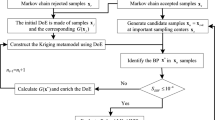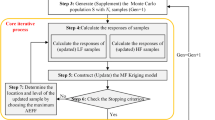Abstract
A new hybrid method is proposed to estimate the failure probability of a structure subject to random parameters. The high dimensional model representation (HDMR) combined with artificial neural network (ANN) is used to approximate implicit limit state functions in structural reliability analysis. HDMR facilitates the lower dimensional approximation of the original limit states function. For evaluating the failure probability, a first-order HDMR approximation is constructed by deploying sampling points along each random variable axis and hence obtaining the structural responses. To reduce the computational effort of the evaluation of limit state function, an ANN surrogate is trained based on the sampling points from HDMR. The component of the approximated function in HDMR can be regarded as the input of the ANN and the response of limit state function can be regarded as the target for training an ANN surrogate. This trained ANN surrogate is used to obtain structural outputs instead of directly calling the numerical model of a structure. After generating the ANN surrogate, Monte Carlo simulation (MCS) is performed to obtain the failure probability, based on the trained ANN surrogate. Three numerical examples are used to illustrate the accuracy and efficiency of the proposed method.
Similar content being viewed by others
References
DITLEVSEN O, MADSEN H O. Structural reliability methods [M]. Chichester: John Wiley & Sons, 1996.
BUCHER C. Computational analysis of randomness in structural mechanics [M]. London: CRC Press, 2009.
LIU P L, DERKIUREGHIAN A. Finite element reliability of geometrically nonlinear uncertain structures [J]. Journal of Engineering Mechanics, 1988, 117(8): 164–168.
PENMETSA R C, GRANDHI R V. Adaptation of fast Fourier transformations to estimate structural failure probability [J]. Finite Elements in Analysis and Design, 2003, 39(5, 6): 473–485.
WU Y T, TORNG T R. A fast convolution procedure for probabilistic engineering analysis [C]//Proceeding of the First International Symposium on Uncertainty Modeling and Analysis. College park, Maryland, USA: IEEE, 1990: 670–675.
ZHAO Y G, ONO T. Moment methods for structural reliability [J]. Structural Safety, 2001, 23(1): 47–75.
LU Z H, ZHAO Y G, ANG A H S. Estimation of load and resistance factors based on the fourth moment method [J]. Structural Engineering and Mechanics, 2010, 36(1): 19–36.
ZHAO Y G, LU Z H. Applicable range of the fourth-moment method for structural reliability [J]. Journal of Asian Architecture & Building Engineering, 2007, 6(1): 151–158.
RUBINSTEIN R Y, KROSES D P. Simulation and the Monte Carlo method [M]. New Jersey: John Wiley & Sons, 2017.
SOBOL I M. Theorems and examples on high dimensional model representations [J]. Reliability Engineering and System Safety, 2003, 79(2): 187–193.
SOBOL I M. Sensitivity analysis for non-linear mathematical models [J]. Mathematical Modeling & Computational Experiment, 1993, 1(4): 407–414.
RAO B N, CHOWDHURY R. Probabilistic analysis using high dimensional model and fast Fourier transform [J]. International Journal for Computational Methods in Engineering Science and Mechanics, 2008, 9(6): 342–357.
CHOWDHARY R, RAO B N, PRASAD A M. High dimensional model representation for structural reliability analysis [J]. Communications in Numerical Methods in Engineering, 2009, 25(4): 301–337.
RAO B N, CHOWDHARY R, SINGH C R, KUSHWAHA H S. Structural reliability analysis of AHWR and PHWR inner containment using high dimensional model representation [C]//Proceedings of 2nd International Conference on Reliability, Safety & Hazard (ICRESH-2010). Mumbai, India: IEEE, 2010: 78–86.
WANG H, TANG L, LI G Y. Adaptive MLS-HDMR metamodeling techniques for high dimensional problems [J]. Expert Systems with Applications, 2011, 38(11): 14117–14126.
SHAN S, WANG Gary. Development of adaptive RBF-HDMR model for approximating high dimensional problems [C]//Proceedings of the ASME 2009 International Design Engineering Technical Conferences & Computers and Information in Engineering Conference. San Diego, California, USA: ASME, 2009: 727–740.
ZHOU C C, LU Z Z, LI G J. A new algorithm for variance based importance measures and importance kernel sensitivity [J]. Proceedings of the Institution of Mechanical Engineers Part O: Journal of Risk and Reliability, 2013, 227(1): 16–27.
LI G, ROSENTHAL C, RABITZ H. High dimensional model representation [J]. Journal of Physical Chemistry, 2001, 105(55): 7765–7777.
RABITZ H, ALIS O F. General foundations of high-dimensional model representations [J]. Journal of Mathematical Chemistry, 1999, 25(2, 3): 197–233.
CHOWDHURY R, RAO B N, PRASAD A M. High dimensional model representation for piece wise continuous function approximation [J]. Communications in Numerical Methods in Engineering, 2008, 24(12): 1587–1609.
MACLEOD C. An introduction to practical neural networks and genetic algorithms for engineers and scientists [M]. Scotland: The Robert Gordon University, 2010.
LEVENBERG K. A method for the solution of certain non-linear problems in least squares [J]. Quarterly of Applied Mathematics, 1944, 2(2): 164–168.
MARQUARDT D W. An algorithm for least square estimation for non-linear parameters [J]. Journal of the Society for Industrial and Applied Mathematics, 1963, 11(2): 431–441.
BROOMHEAD D S, LOWE D. Multivariable functional interpolation and adaptive networks [J]. Complex Systems, 1988, 2(1): 321–355.
MOODY J, DARKEN C J. Fast learning in networks of locally tuned processing units [J]. 1989, 1(2): 281–294.
BISHOP CM. Neural networks for pattern recognition [M]. Oxford: Clarendon Press, 1995.
HAYKIN S. Neural Networks: A comprehensive foundation [M]. New Jersey: Prentice-Hall, 1999.
KIM S H, NA S W. Response surface method using vector projected sampling points [J]. Structural Safety, 1997, 19(1): 3–19.
Author information
Authors and Affiliations
Corresponding author
Additional information
Foundation item: Project(U1533109) supported by the National Natural Science Foundation, China; Project supported by the Priority Academic Program Development of Jiangsu Higher Education Institutions, China
Rights and permissions
About this article
Cite this article
Jha, B.N., Li, Hs. Structural reliability analysis using a hybrid HDMR-ANN method. J. Cent. South Univ. 24, 2532–2541 (2017). https://doi.org/10.1007/s11771-017-3666-7
Received:
Accepted:
Published:
Issue Date:
DOI: https://doi.org/10.1007/s11771-017-3666-7




